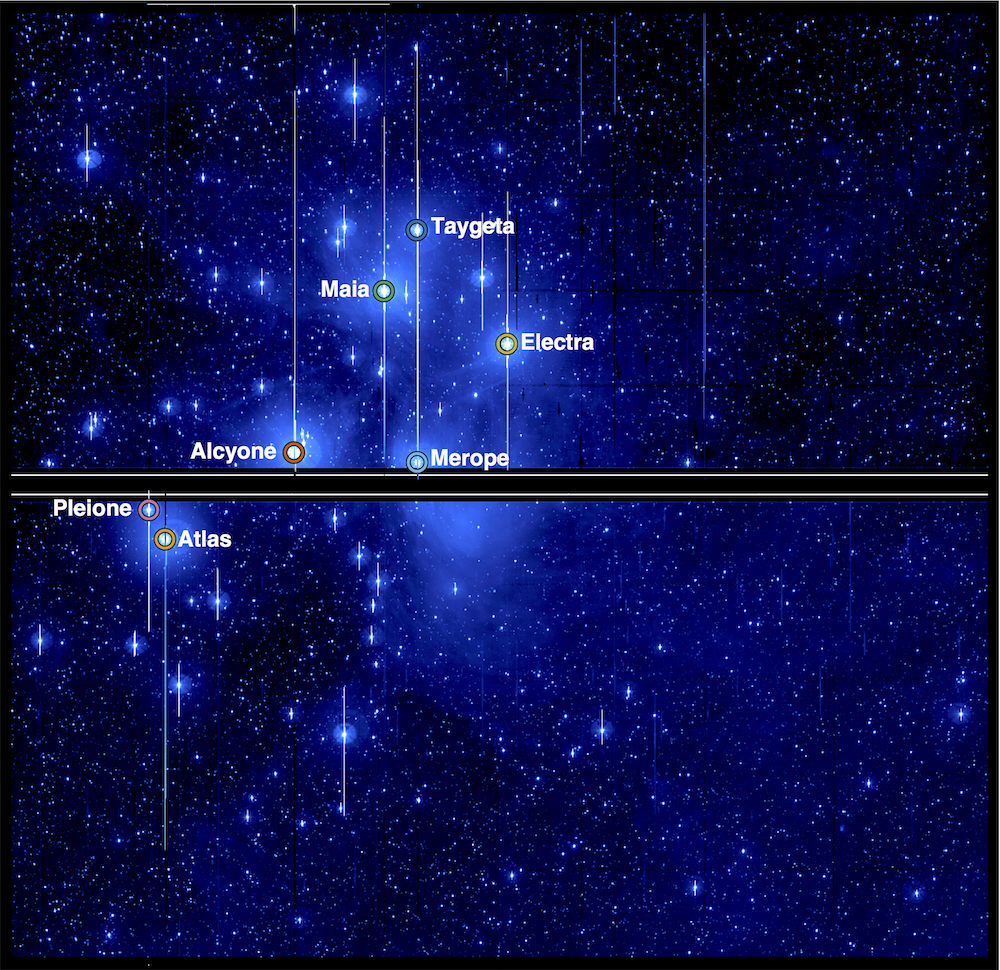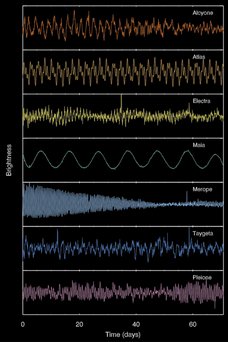Kepler satellite discovers variability in the Seven Sisters
Using the Pleiades as guinea-pigs for new photometric method. Tim White as lead author and several other researchers related to SAC have a paper out in Monthly Notices of the Royal Astronomical Observatory, titled 'Beyond the Kepler/K2 bright limit: variability in the seven brightest members of the Pleiades'.

The astronomers will never be content! They strive to observe the faintest stars possible, and this means that some of the brighter stars are actually too bright to observe with modern equipment. A workaround to this has now been developed by an international group of astronomers led by Tim White of Stellar Astrophysics Centre, Aarhus University and the method has been tested successfully on the seven brightest stars in the open cluster named the Pleiades or the Seven Sisters.
Caption: This image from NASA’s Kepler spacecraft shows members of the Pleiades star cluster taken during Campaign 4 of the K2 Mission. Credit: NASA / Aarhus University / T. White
Click on the image to download a short mp4 video of the Pleiades.
Aiming a beam of light from a bright star at a point on a CCD detector will cause several of the central pixels of the star's image to be saturated, and the construction of the CCD will cause long ghost images of saturated pixels in various directions out from the center of the image. Saturation means a loss of precision in the measurement of the total brightness of the star. The solution is simple: the star is bright enough that you can skip all the saturated pixels, selecting a set of unsaturated positions on the CCD hit by enough light that you can still make a reliable measurement of the brightness variations that are of interest if you want to do asteroseismology, observing the regular short time variations or if you want to see if an exoplanet passes in front of the star causing the intensity to drop shortly.
This new method has been named halo photometry. It is simple and fast and it has been used by the authors for observing the seven brightest named stars in the open cluster using data from the extended K2 mission by the NASA Kepler satellite.
The light curves of the seven brightest stars in the Pleiades. Maia is obviously the odd sister out. The unique brightness fluctuations of each star reveal clues about their physical properties such as their size and rotation rate. Credit: Aarhus University / T. White
Most of the seven stars are revealed to be slowly-pulsating B stars, a class of variable star in which the star's brightness changes with day-long periods. The frequencies of these pulsations are key to exploring some of the poorly understood processes in the core of these stars. The seventh star, Maia, is different: it varies with a regular period of 10 days. Previous studies have shown that Maia belongs to a class of stars with abnormal surface concentrations of some chemical elements such as manganese. To see if these things were related, a series of spectroscopic observations were taken with the Hertzsprung SONG Telescope. "What we saw was that the brightness changes seen by Kepler go hand-in-hand with changes in the strength of manganese absorption in Maia's atmosphere," said Victoria Antoci, a co-author of the work and Assistant Professor at the Stellar Astrophysics Centre, Aarhus University. "We conclude that the variations are caused by a large chemical spot on the surface of the star, which comes in and out of view as the star rotates with a ten day period." "Sixty years ago, astronomers had thought they could see variability in Maia with periods of a few hours and suggested this was the first of a whole new class of variable stars they called 'Maia Variables'," White said, "but our new observations show that Maia is not itself a Maia Variable!"
A longer press release from MNRAS is available here as is also the paper from arXiv.


